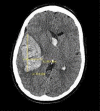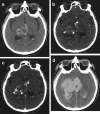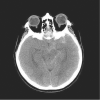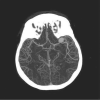Intracranial hemorrhage
- PMID: 22974648
- PMCID: PMC3443867
- DOI: 10.1016/j.emc.2012.06.003
Intracranial hemorrhage
Abstract
Intracranial hemorrhage refers to any bleeding within the intracranial vault, including the brain parenchyma and surrounding meningeal spaces. This article focuses on the acute diagnosis and management of primary nontraumatic intracerebral hemorrhage and subarachnoid hemorrhage in the emergency department.
Copyright © 2012 Elsevier Inc. All rights reserved.
Figures




Similar articles
-
Systems and diseases. Nervous system 10. The pathophysiology of intracranial hemorrhage and its management.Nurs Times. 2001 May 31-Jun 6;97(22):43-6. Nurs Times. 2001. PMID: 11954433 Review. No abstract available.
-
[Acute care of intracerebral hemorrhage is improving].Duodecim. 2005;121(22):2449-52. Duodecim. 2005. PMID: 16457076 Review. Finnish. No abstract available.
-
Intracranial Hemorrhage and Intracranial Hypertension.Emerg Med Clin North Am. 2019 Aug;37(3):529-544. doi: 10.1016/j.emc.2019.04.001. Emerg Med Clin North Am. 2019. PMID: 31262419 Review.
-
Intracranial hemorrhage: diagnosis and management.Neurol Clin. 2012 Feb;30(1):211-40, ix. doi: 10.1016/j.ncl.2011.09.002. Neurol Clin. 2012. PMID: 22284061 Review.
-
Can circadian rhythms influence onset and outcome of nontraumatic subarachnoid hemorrhage?Am J Emerg Med. 2007 Jul;25(6):728-30. doi: 10.1016/j.ajem.2006.11.048. Am J Emerg Med. 2007. PMID: 17606104 No abstract available.
Cited by
-
Hemorrhagic encephalopathies and myelopathies in dogs and cats: a focus on classification.Front Vet Sci. 2024 Oct 28;11:1460568. doi: 10.3389/fvets.2024.1460568. eCollection 2024. Front Vet Sci. 2024. PMID: 39529855 Free PMC article. Review.
-
Clinical and subclinical acute brain injury caused by invasive cardiovascular procedures.Nat Rev Cardiol. 2024 Oct 11. doi: 10.1038/s41569-024-01076-0. Online ahead of print. Nat Rev Cardiol. 2024. PMID: 39394524 Review.
-
Angiomatouse meningioma with intracerebral hemorrhage: A case report and literature review.Radiol Case Rep. 2024 Aug 23;19(11):5178-5181. doi: 10.1016/j.radcr.2024.06.081. eCollection 2024 Nov. Radiol Case Rep. 2024. PMID: 39263495 Free PMC article.
-
A Case of Basal Ganglia Intraparenchymal Hemorrhage Following Lumbar Spinal Surgery.Cureus. 2024 Jul 29;16(7):e65692. doi: 10.7759/cureus.65692. eCollection 2024 Jul. Cureus. 2024. PMID: 39211708 Free PMC article.
-
Establishing a Foundation for the In Vivo Visualization of Intravascular Blood with Photon-Counting Technology in Spectral Imaging in Cranial CT.Diagnostics (Basel). 2024 Jul 19;14(14):1561. doi: 10.3390/diagnostics14141561. Diagnostics (Basel). 2024. PMID: 39061698 Free PMC article.
References
-
- van Asch CJJ, et al. Incidence, case fatality, and functional outcome of intracerebral haemorrhage over time, according to age, sex, and ethnic origin: a systematic review and meta-analysis. The Lancet Neurology. 2010;9(2):167–176. - PubMed
-
- Aguilar MI, Freeman WD. Spontaneous intracerebral hemorrhage. Semin Neurol. 2010;30(5):555–64. - PubMed
-
- Broderick J, et al. Guidelines for the Management of Spontaneous Intracerebral Hemorrhage in Adults. Stroke. 2007;38(6):2001–2023. - PubMed
-
- Elliott J, Smith M. The Acute Management of Intracerebral Hemorrhage: A Clinical Review. Anesthesia & Analgesia. 2010;110(5):1419–1427. - PubMed
-
- Feigin VL, et al. Worldwide stroke incidence and early case fatality reported in 56 population-based studies: a systematic review. The Lancet Neurology. 2009;8(4):355–369. - PubMed
Publication types
MeSH terms
Grants and funding
LinkOut - more resources
Full Text Sources
Other Literature Sources


